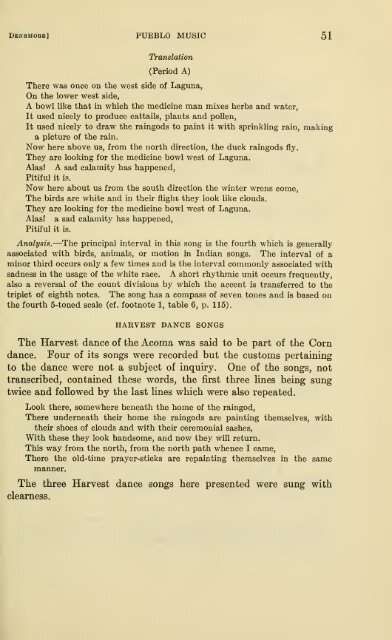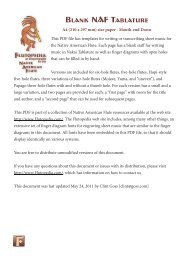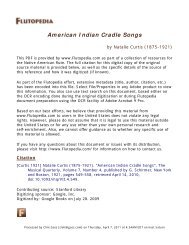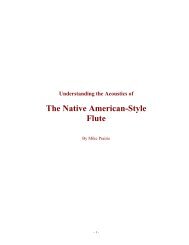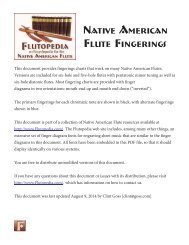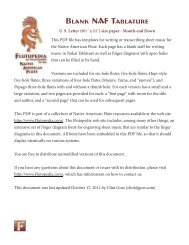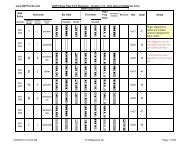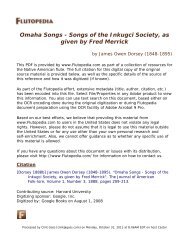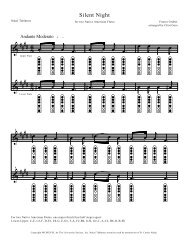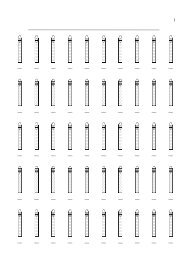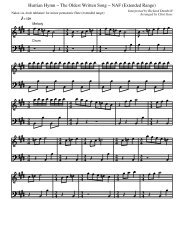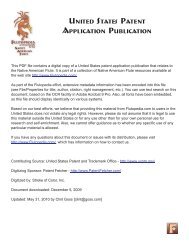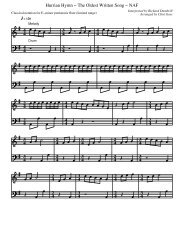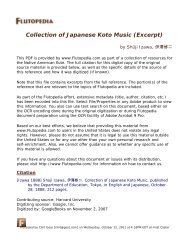Music of Acoma, Isleta, Cochiti, and Zuñi Pueblos - Flutopedia.com
Music of Acoma, Isleta, Cochiti, and Zuñi Pueblos - Flutopedia.com
Music of Acoma, Isleta, Cochiti, and Zuñi Pueblos - Flutopedia.com
Create successful ePaper yourself
Turn your PDF publications into a flip-book with our unique Google optimized e-Paper software.
Dbnsmoeb] pueblo MUSIC 51<br />
Translation<br />
(Period A)<br />
There was once on the west side <strong>of</strong> Laguna,<br />
On the lower west side,<br />
A bowl like that in which the medicine man mixes herbs <strong>and</strong> water,<br />
It used nicely to produce cattails, plants <strong>and</strong> pollen,<br />
It used nicely to draw the raingods to paint it with sprinkUng rain, making<br />
a picture <strong>of</strong> the rain.<br />
Now here above us, from the north direction, the duck raingods fly.<br />
They are looking for the medicine bowl west <strong>of</strong> Laguna.<br />
Alas! A sad calamity has happened.<br />
Pitiful it is.<br />
Now here about us from the south direction the winter wrens <strong>com</strong>e.<br />
The birds are white <strong>and</strong> in their flight they look like clouds.<br />
They are looking for the medicine bowl west <strong>of</strong> Laguna.<br />
Alas! a sad calamity has happened,<br />
Pitiful it is.<br />
Analysis.—The principal interval in this song is the fourth which is generally<br />
associated with birds, animals, or motion in Indian songs. The interval <strong>of</strong> a<br />
minor third occurs only a few times <strong>and</strong> is the interval <strong>com</strong>monly associated with<br />
sadness in the usage <strong>of</strong> the white race. A short rhythmic unit occurs frequently,<br />
also a reversal <strong>of</strong> the count divisions by which the accent is transferred to the<br />
triplet <strong>of</strong> eighth notes. The song has a <strong>com</strong>pass <strong>of</strong> seven tones <strong>and</strong> is based on<br />
the fourth 5-toned scale (cf. footnote 1, table 6, p. 115).<br />
HAEVEST DANCE SONGS<br />
The Harvest dance <strong>of</strong> the <strong>A<strong>com</strong>a</strong> was said to be part <strong>of</strong> the Corn<br />
dance. Four <strong>of</strong> its songs were recorded but the customs pertaining<br />
to the dance were not a subject <strong>of</strong> inquiry. One <strong>of</strong> the songs, not<br />
transcribed, contained these words, the first three Hnes being sung<br />
twice <strong>and</strong> followed by the last lines which were also repeated.<br />
Look there, somewhere beneath the home <strong>of</strong> the raingod,<br />
There underneath their home the raingods are painting themselves, with<br />
their shoes <strong>of</strong> clouds <strong>and</strong> with their ceremonial sashes,<br />
With these they look h<strong>and</strong>some, <strong>and</strong> now they will return.<br />
This way from the north, from the north path whence I came,<br />
There the old-time prayer-sticks are repainting themselves in the same<br />
manner.<br />
The three Harvest dance songs here presented were sung with<br />
clearness.


